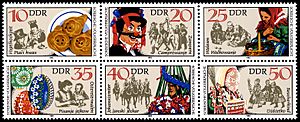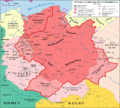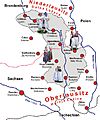Sorbs facts for kids
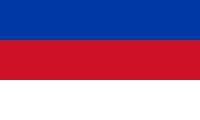
Sorbian flag, in Pan-Slavic colors, introduced in 1842
|
|
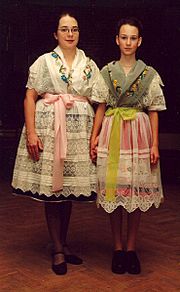
Traditional female costume of Lower Lusatia (Spreewald)
|
|
| Total population | |
|---|---|
| 60,000–80,000 (est.) • 45–60,000 Upper Sorbs • 15–20,000 Lower Sorbs |
|
| Regions with significant populations | |
| 60,000–80,000 | |
| 2,000 | |
| fewer than 1,000 | |
| Languages | |
| Sorbian (Upper Sorbian, Lower Sorbian), German | |
| Religion | |
| Majority Roman Catholicism, Lutheranism | |
| Related ethnic groups | |
| Other West Slavs (especially Silesians and Poles) |
|
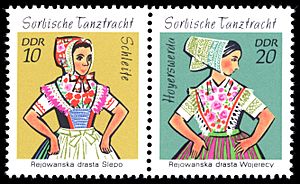
The Sorbs are a special group of people. They are the smallest Slavic ethnic group in the world. Most Sorbs live in Germany and Poland. Today, about 60,000 Sorbs live in Germany. About a third of them live in Brandenburg, where the Spreewald area is. The rest live further south, in Saxony.
The Sorbs are descendants of Slavic tribes. These tribes lived north of the Carpathian Mountains a long time ago. About 1,500 years ago, some of these tribes moved to a region called Lusatia. This area is now part of eastern Germany, western Poland, and the northern Czech Republic.
Sorbs speak their own West Slavic languages. About 20,000 people in Saxony speak Upper Sorbian. This language is similar to Czech. In Brandenburg, about 5,000 people speak Lower Sorbian. This language is more like Polish. Both Sorbian languages are in danger of disappearing. Because of this, they are protected and promoted in their local areas.
In Germany, Upper Sorbian and Lower Sorbian are protected languages. This is thanks to the European Charter for Regional or Minority Languages. This charter helps keep minority languages alive.
Sometimes, American and Australian Sorbian communities use the old words "Wends" or "Wendish". But in Germany and Poland, Sorbs do not use these old-fashioned words to describe themselves.
Contents
Sorbian History and Name
The name "Sorbs" comes from medieval groups called Sorbs (Surbi, Sorabi). The original name, Srbi, was kept by both the Sorbs and the Serbs in the Balkans. By the 6th century, Slavic people lived in the area west of the Oder River. This area was once home to Germanic peoples.
The Sorbs were first mentioned in history around the 6th or 7th century. In their own languages, other Slavic people call them "Lusatian Serbs". The Sorbs call the Serbs "the south Sorbs". The name "Lusatia" first only meant Lower Lusatia. The name *Sŕbъ (plural *Sŕby) likely means "family kinship" or "alliance" in the old Proto-Slavic language.
Sorbian Traditions and Culture
Sorbs have many unique traditions. One of the most popular is the Shrove Tuesday festival called Zapust. This festival is closely connected to the community's working life. In the past, the celebrations would last a week. They happened before the spring planting of fields. People would wear traditional clothes, have parades, and dance.
Egg decorating is another special Sorbian tradition. It is a Slavic Easter custom. Sorbs have been decorating eggs, called pisanici, since the 17th century.
Protecting Sorbian Culture
Sorbs have worked hard to keep their culture alive. In 1904, the most important Sorbian cultural center was built in Bautzen. It is called the Sorbian House. In 1912, a group called the Domowina Institution was created. This group is a union of Sorbian organizations. It helps protect Sorbian social and cultural life. By 1919, it had 180,000 members.
In 1920, Jan Skala started a Sorbian political party. In 1925, he also started a newspaper called Kulturwille in Berlin. This newspaper worked to protect national minorities in Germany. Also in 1920, the Sokol Movement was founded. This was a youth movement and a gymnastics organization.
However, from 1933, the Nazi party began to stop Sorbian culture. They closed the Sokol Movement. They fought against every sign of Sorbian culture. In 1937, the Domowina Institution and other Sorbian groups were banned. This meant they were not allowed to operate. Sorbian priests and teachers were forced to leave Lusatia. Nazi German authorities took over the Sorbian House and other Sorbian buildings and farms.
After World War II, the Domowina Institution started again. This happened on May 10, 1945, in Crostwitz. In 1948, the Landtag (parliament) of Saxony passed a law to protect Sorbian Lusatians. In 1949, Brandenburg passed a similar law. The constitution of East Germany also protected the Sorbian language and culture. This was stated in Article 40, adopted on October 7, 1949.
Sorbian National Symbols
The flag of the Lusatian Sorbs has three horizontal stripes: blue, red, and white. It was first used as a national symbol in 1842. By 1848, Sorbs recognized it as their flag. The constitution of Brandenburg has a rule about the Lusatian flag. The constitution of Saxony also has a rule about using the coat of arms and traditional colors of the Lusatian Sorbs. Laws in both Brandenburg and Saxony protect the use of Sorbian national symbols.
The national anthem of the Lusatian Sorbs is a song called Rjana Łužica (Beautiful Lusatia). This has been their anthem since the 20th century. Before that, other songs were used. These included "Still Sorbs Have Not Perished" (written in 1840) and "Our Sorbs Rise from the Dust" (used until 1945).
Images for kids
-
"House of the Sorbs" (Serbski dom) in Bautzen
-
Bautzen, German-Sorbian folk theatre
-
Bilingual names of streets in Cottbus
-
Lusatia was part of the Polish state between 1002 and 1031 under the rule of Bolesław I.
See also
 In Spanish: Sorbios para niños
In Spanish: Sorbios para niños


